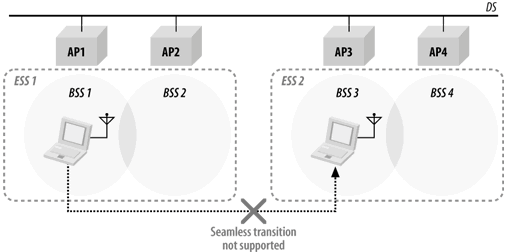Designing Networks for Mobility
Most networks are designed so that a group of access points provides access to a group of resources. All the access points under control of the networking organization are assigned to the same SSID, and clients are configured to use that SSID when connecting to the wireless network.
As client systems move around, they continuously monitor network connectivity, and shift between access points in the same SSID. 802.11 ensures that clients will be able to move associations between the access points in the same SSID, but network architects must build the network to support mobile clients. Small networks are often built on a single VLAN with a single subnet, in which case there is no need to worry about mobility. Larger networks that span subnet boundaries must apply some additional technology to provide mobility support. Many products can work.

with a VLAN core, which allows clients to always attach to the same VLAN throughout an organization. New products even allow dynamic VLAN assignment based on authentication data. When users connect to the network, they are attached to the same VLAN everywhere; the switched network simply requires that the wireless LAN device tag frames appropriately. Some products support the Mobile IP standard, or use VPN technology creatively.
In this tutorial:
- 802.11 Networks
- IEEE 802 Network Technology Family Tree
- Nomenclature and Design
- Types of Networks
- Independent networks
- Infrastructure networks
- Extended service areas
- Multi-BSS environments: "virtual APs"
- Robust security networks (RSNs)
- The Distribution System, Revisited
- Interaccess point communication as part of the distribution system
- Wireless bridges and the distribution system
- Network Boundaries
- 802.11 Network Operations
- Network Services
- Station services
- Distribution system services
- Confidentiality and access control
- Spectrum management services
- Mobility Support
- Designing Networks for Mobility
